Who Is Fabian Hürzeler?
Under Fabian Hürzeler coaching style, Brighton & Hove Albion have experienced a tactical transformation this season, thrilling fans and analysts with their intricate, dynamic play.
In this tactical analysis, we’ll
examine their recent matches from the EPL season to further analyzetheir tactics and strategies.
Earlier this year
, we analyzed Fabian Hürzeler’s tactics at FC St. Pauli. Hehas brought that same philosophy around fluidity in possession, seamlessly linking the build-up, midfield control, and attack to Brighton.
On the defensive side, Brighton are a very aggressive, pressing team with clever positioning; they constantly disrupt their opponents’ build-up patterns.
This analysis will highlight Fabian Hürzeler‘s approach to helping Brighton thrive, combining tactical intelligence with a relentless work ethic to redefine modern football at the club.
Fabian Hürzeler Tactical Philosophy
Fabian Hürzeler’s possession-based style focuses on controlling the tempo through dynamic, vertical, and passing.
“I try to convince my players by using the power of ideas. I want to value and improve every player … that’s my leadership style.” – Fabian Hürzeler.
Tactical flexibility is another cornerstone of Hürzeler’s philosophy.
Based on the opponent’s setup, Fabian Hurzeler style of play frequently adapts formations, such as shifting between a 4-2-4, 4-3-3 and a 4-1-4-1.
Whether pressing high or sitting in a deeper block, Hürzeler’s aim is always to maximise control and fluidity on the pitch.
Structural integrity awards territory, and efficacy with space wins games.
Fabian Hürzeler Tactics In Build-Up
Brighton’s build-up play under Hürzeler begins with a fluid 4-2-4 structure that adjusts to the opposition’s pressing shape.
At times, their build-up shape transitions into a 4-3-3, with a single pivot and two players occupying the number 8 central roles, forming a compelling triangle to facilitate vertical passing.
With the wing-backs positioned so high and the two number 8s a few yards ahead of the pivot, it can resemble a 2-5-3 formation.
Hürzeler emphasises quick transitions from the back, with the full-backs pushing high to create wide overloads, ensuring smooth ball progression.
Brighton plays with the idea of extensive passing, trying to play vertical passes up the pitch to expand central areas rather than trying to work it out with the wing-back, which is the approach most teams use.
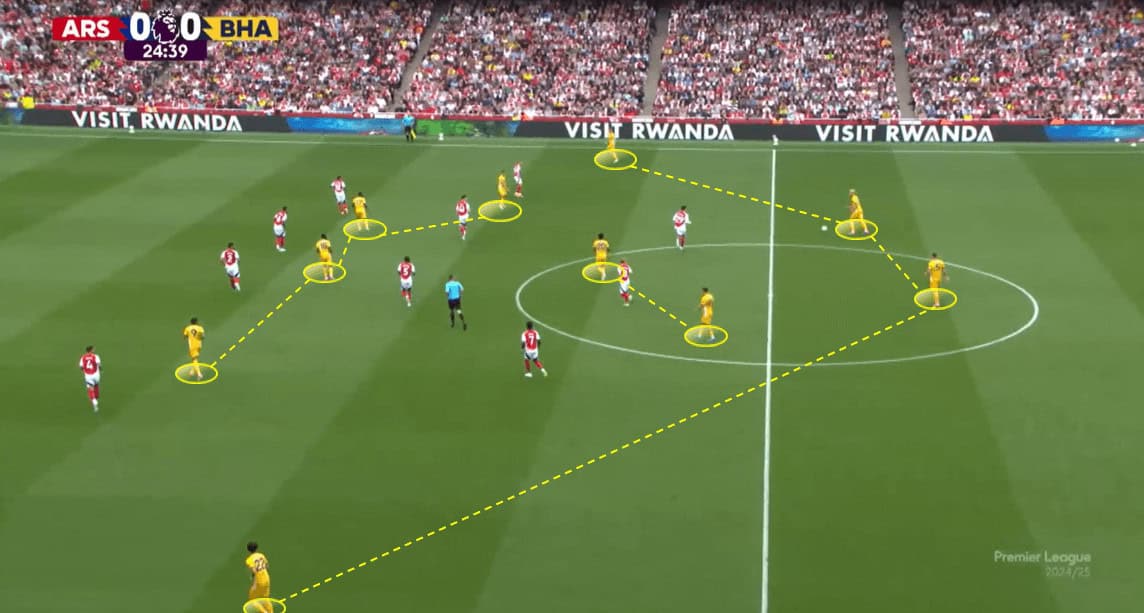
In the first image, we observe Brighton setting up in a 4-2-4 formation, focusing on utilising their wing-backs to stretch the opposition.
The right centre-back (RCB) is in possession, allowing the left wing-back to push high and wide.
This creates an overload on the right side, tilting the field and allowing Brighton to make a quick transition to their left, where their wide player is high and wide with lots of space to exploit.
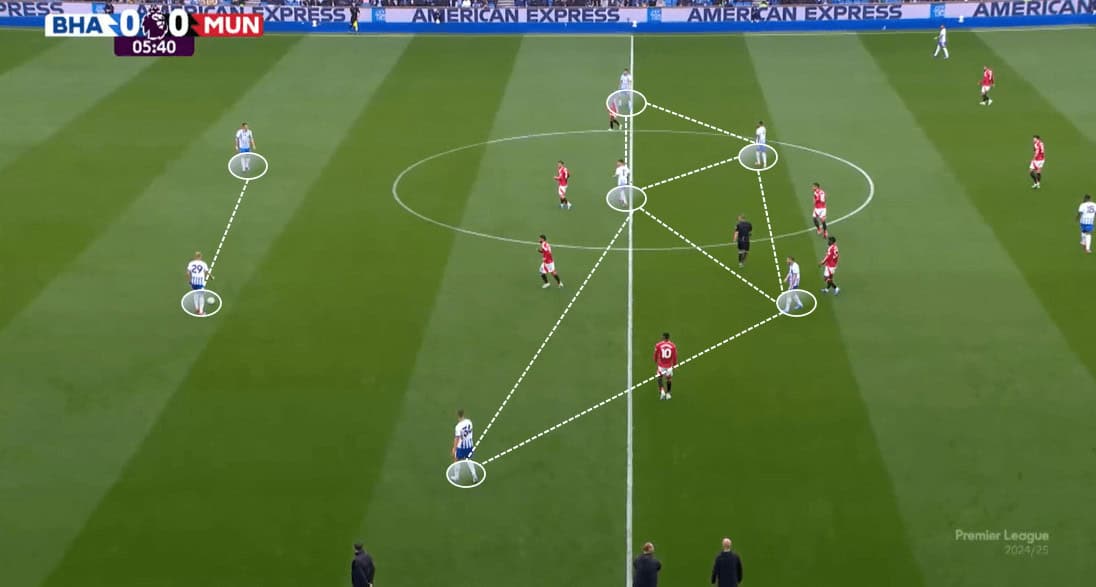
In this second image, we can see the 4-3-3 formation, which effectively becomes a 2-5-3 due to how high the full-backs are positioned, nearly parallel with the pivot player, Billy Gilmour.
This setup creates triangles in the central areas of the pitch, ensuring that no matter who has the ball, there is always an angled forward pass available, provided the players’ decision-making aligns with the tactical approach.
Notice the three triangles in the image.
The pivot player is crucial as he connects all three triangles.
Why do they change their build-up?
Brighton adjusts their build-up tactics based on the opposition’s pressing structure to find the most effective way to progress the ball.
Against teams pressing in a 4-3-3, like Arsenal, Brighton’s double pivot engages the opposition’s first defensive line, keeping them close and preventing them from effectively pressing other Brighton players.
In this scenario, players like Ødegaard, Saka, and Havertz position themselves close together, cutting off central passing lanes to the double pivot but allowing Brighton to progress through the wide channels.
However, in the match against Manchester United, Brighton switched to using a single pivot.
United pressed in a 4-2-4 formation, and sticking with a double pivot would have overcrowded central areas, playing into United’s defensive structure.
Instead, Brighton opted for a single pivot with two advanced midfielders ahead, allowing them to bypass United’s first defensive block and progress the ball vertically into the final third, enabling quicker transitions.
Fabian Hürzeler Midfield Transitions
Brighton have multiple ways to transition the ball into midfield, where they look to penetrate space.
Brighton employs a 1-1 pivot system using a double pivot, with one of the midfielders dropping between the centre-backs.
This setup allows the deeper pivot to operate as a deep-lying playmaker, breaking the opponent’s press through vertical passes into central areas.
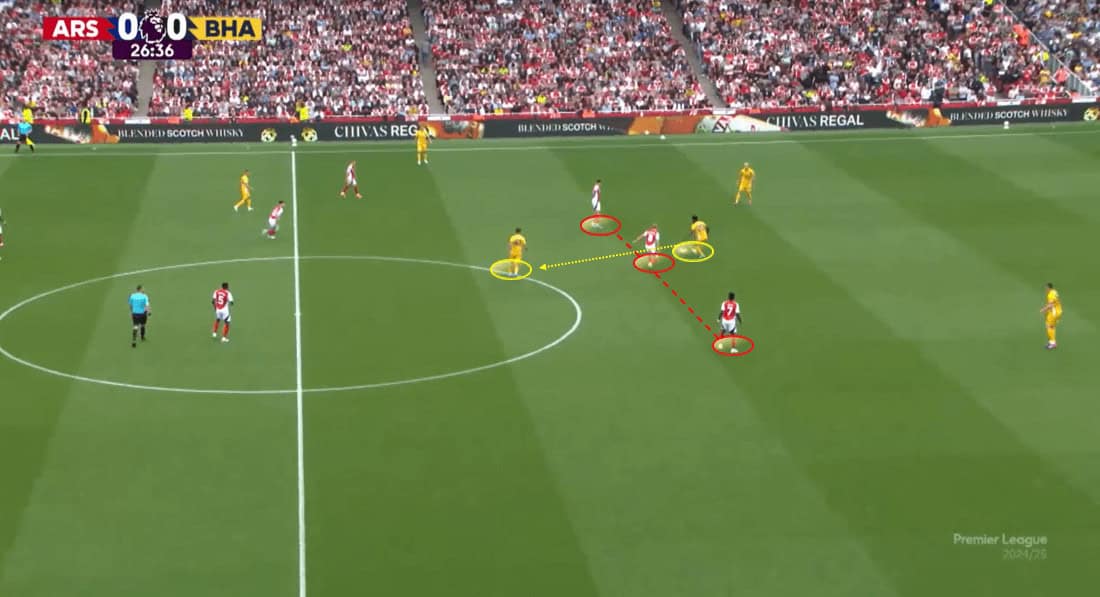
The first image shows the pivot dropping between the two centre-backs, creating the 1-1 midfield formation.
This allows him to break Arsenal’s press with a vertical pass, enabling the midfielder to turn into space and initiate the transition.
This positioning helps bypass Arsenal’s high press by offering an extra outlet.
The goal is to break through the opponent’s defensive lines using precise vertical passes.
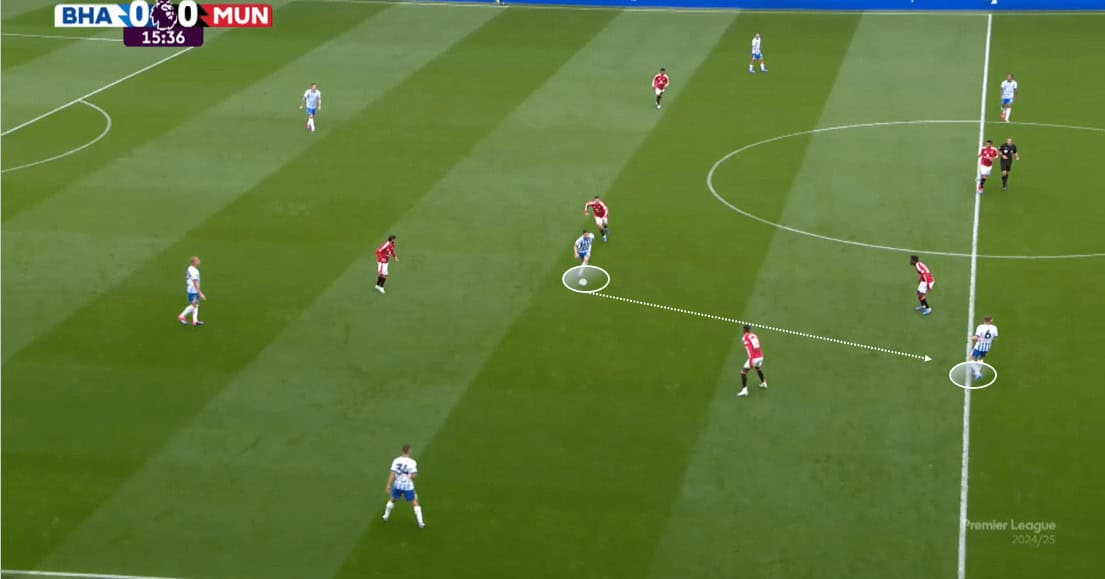
Once again, Brighton’s focus on vertical passes and stretching the pitch vertically comes into play, but this time with a single pivot.
Gilmour excels at positioning himself in these zones of the pitch where he can advance the team forward.
The two players in front of him aim to drop between two opposition players, creating the opportunity for a vertical pass.
This allows them to reenter space and initiate the midfield transition.
Brighton’s focus on quick, vertical transitions from defence to attack allows them to exploit spaces left by the opposition, ensuring they are always well-positioned to switch into their attacking shape.
Fabian Hürzeler Attacking Phase
Brighton’s attacking structure frequently shifts into a dynamic 4-3-3, prioritising width and quick combinations in the half-spaces.
The full-backs push forward to support the wingers, creating overloads destabilising the opposition’s defence.
This movement opens up space for the central midfielders to exploit, generating goal-scoring opportunities.
Brighton often utilises central runners, whether it’s midfielders pushing forward centrally or wide players occupying those spaces when available.
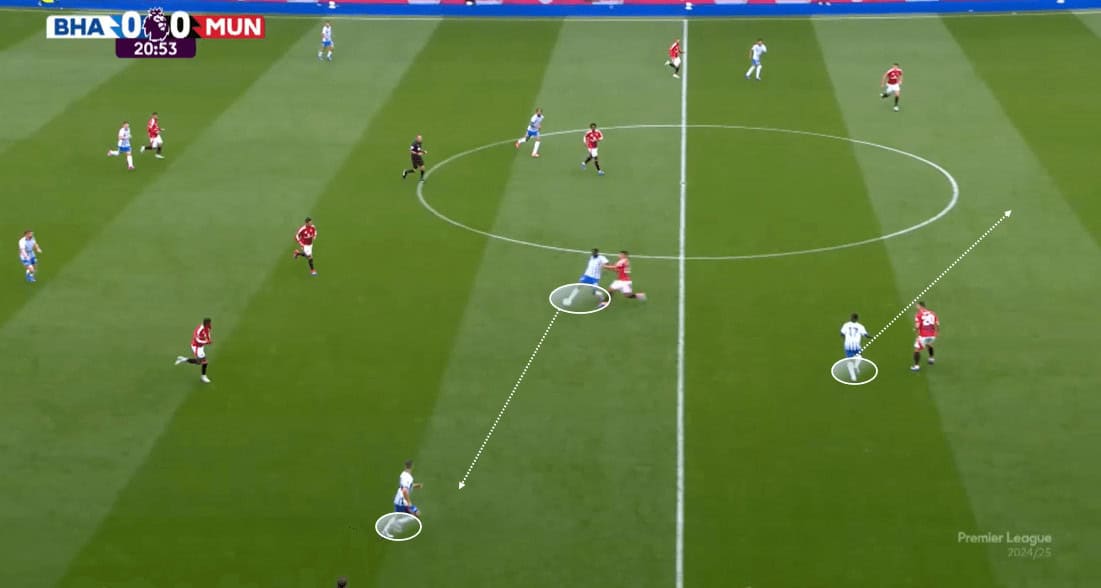
In the first image, we see a combination of play on the right side of the pitch.
The player marked in white is darting into the number 9 position, allowing the wide player to drag someone like Dalot out of position, creating space to play him through.
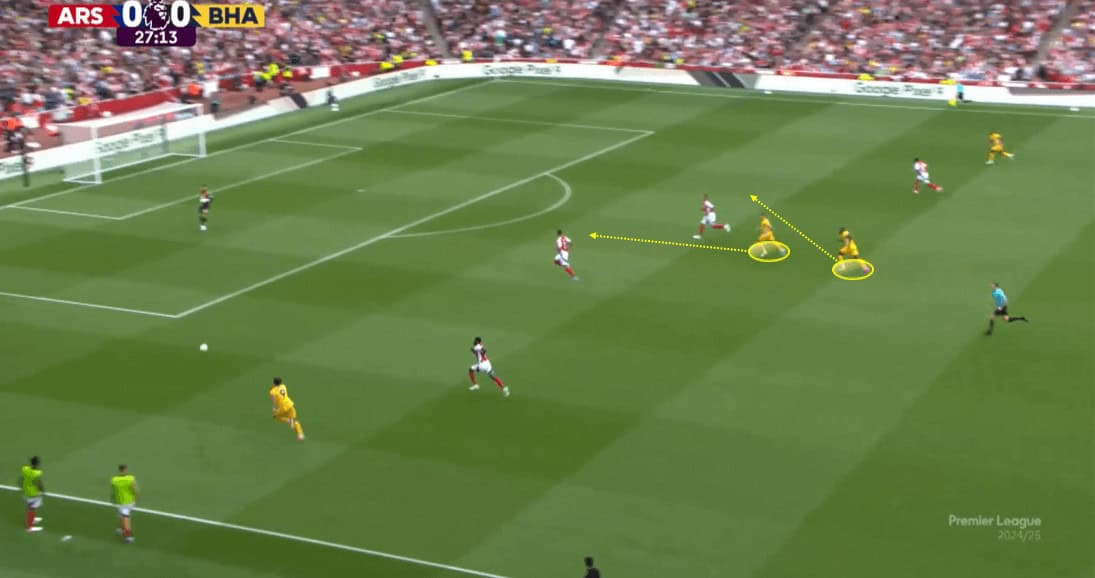
Another example is seen here, where João Pedro is running down the flank, with two Brighton players making central runs into the box.
Instead of moving wide to offer support, they trust their wide players to progress the ball centrally into dangerous areas.
Pressing In The Opponent’s Half
Brighton uses two formations when pressing in the opponent’s half: a 4-2-4 and a 4-4-2, each effective in different scenarios.
When facing teams with stronger passers, they opt for a 4-2-4, aiming to cut off passing options to the midfield.
Positioning more players up front effectively blocks the passing lanes and limits the opposition’s ability to play through the centre.
In a 4-4-2, Brighton takes a more conservative approach, sitting deeper and waiting for the ball to reach midfield.
Once it does, they engage in duels to win possession; they commit fewer players forward in this setup, as they are less concerned with the centre-backs playing into the midfield.
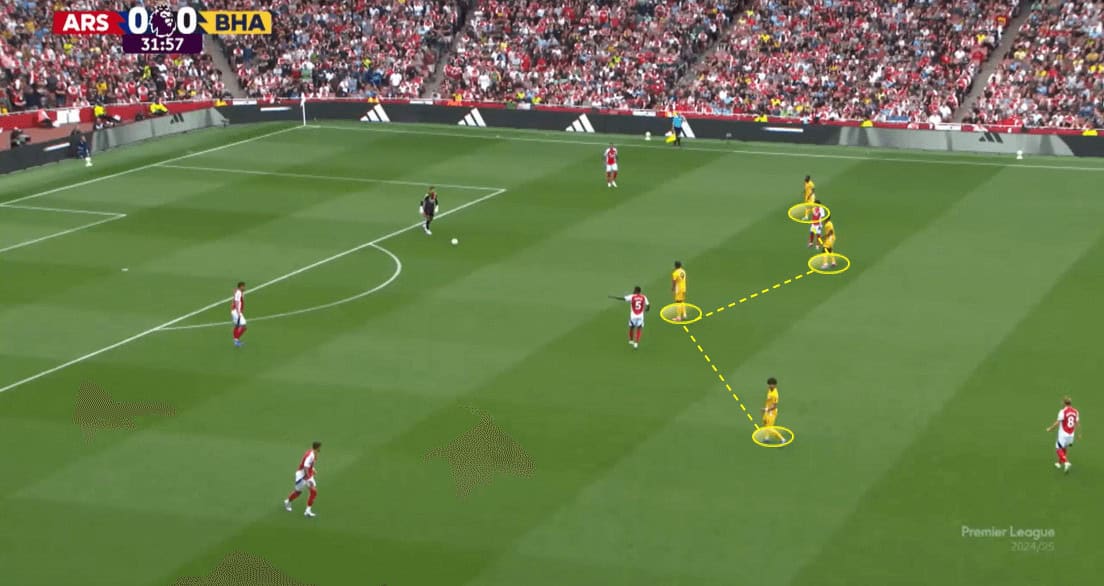
In the first image, Brighton press in a compact four-man defensive line.
Rather than man-marking Arsenal’s centre-backs or central midfielders, Brighton focus on cutting off central passing lanes.
The intention is to prevent Arsenal’s strongest players—such as Rice, Ødegaard, and Partey—from receiving the ball in dangerous areas.
By denying vertical progression through the centre, Brighton force Arsenal to rely on their wide players to move the ball forward, limiting their central playmaking options.
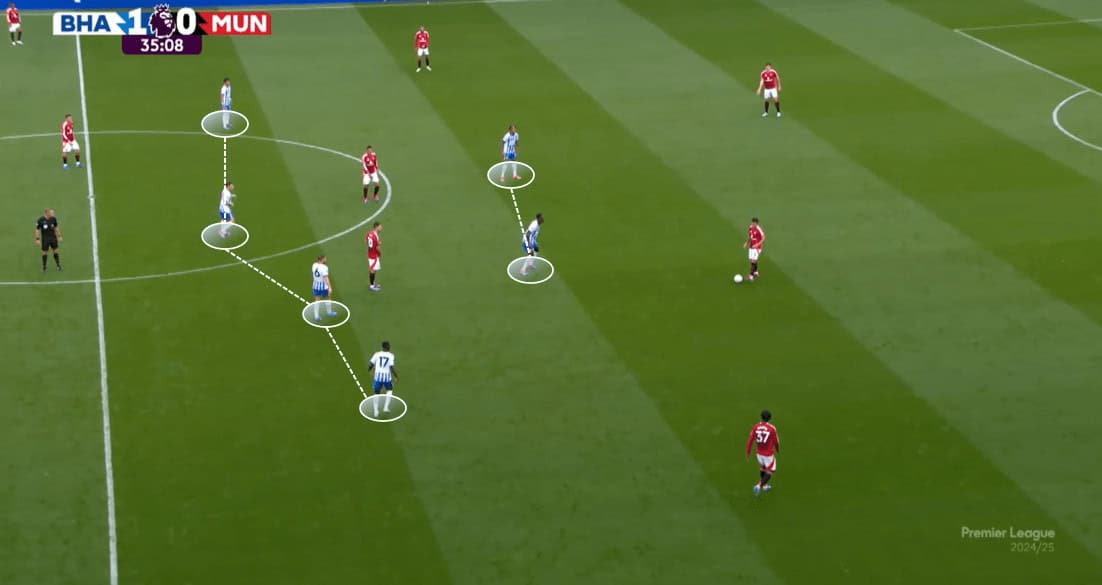
In the image above, Brighton don’t commit as many numbers forward in the first defensive line, as they don’t perceive United to be as dangerous with the ball in midfield.
Instead, they focus on cutting off passing lanes using a dual striker partnership up front while maintaining a four-man defensive line for protection behind, in case the ball progresses forward.
Pressing In Their Own Half
When defending in their own half, Brighton excel at maintaining compactness in a low block, especially near the edge of the penalty box.
They set up in a 5-4-1 formation or a 4-1-4-1, with a second player from the second defensive line coming forward to help the press, essentially creating a 4-1-3-2.
Their focus is shutting down central areas and forcing the opposition to play out wide.
This disciplined approach is paired with swift counterattacks, using direct long balls to exploit the opposition’s disorganization during transitions.
With their rapid wide players, counterattacking is a perilous threat they bring to the table.
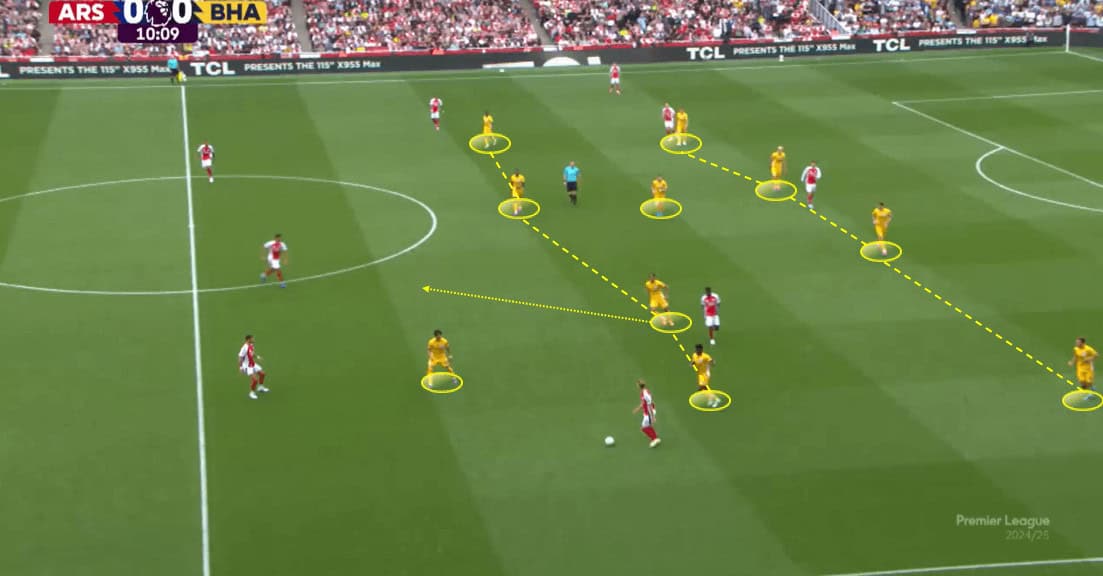
Brighton set up into a 4-1-4-1 formation, which can shift into a 4-1-3-2, depending on the situation.
One player from the second line of four moves forward to cut off passing options, applying pressure while maintaining the defensive shape.
The holding midfielder anchors the space in front of the back four, controlling central areas and preventing Arsenal from quickly transitioning from side to side or progressing vertically.
This setup proved highly effective in slowing down Arsenal’s build-up and limiting their ability to stretch the field both horizontally and vertically.
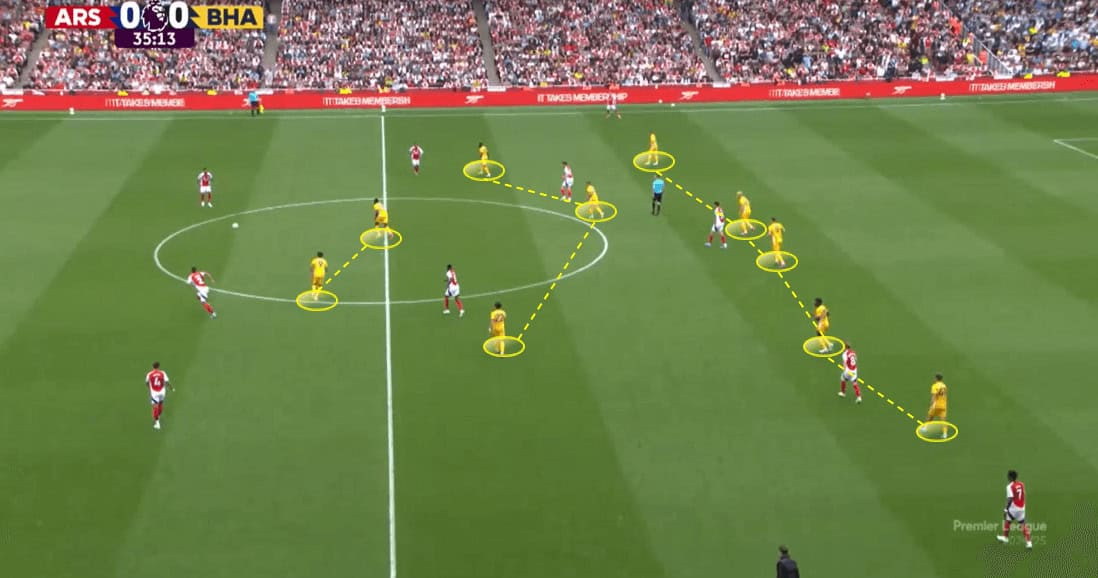
In this image, we can see the flexibility of Brighton’s players, now sitting back in a 5-3-2 formation.
This setup is typically used when the team is under pressure from the opposition; it provides more defensive coverage than the team’s usual shape.
Conclusion
Under Fabian Hürzeler’s leadership, Brighton & Hove Albion have undergone a tactical transformation, blending flexibility, control, and a high-intensity work ethic.
Hürzeler’s adaptable formations and focus on possession-based play have made Brighton a tactically versatile team capable of dictating the pace in both offensive and defensive phases.
His dynamic positioning, vertical passing, and smart pressing strategies allowed the team to break through opposition lines while maintaining a strong defensive structure.
This balance between fluid attacking play and aggressive pressing has positioned Brighton as one of the most tactically sophisticated teams in the Premier League this season.

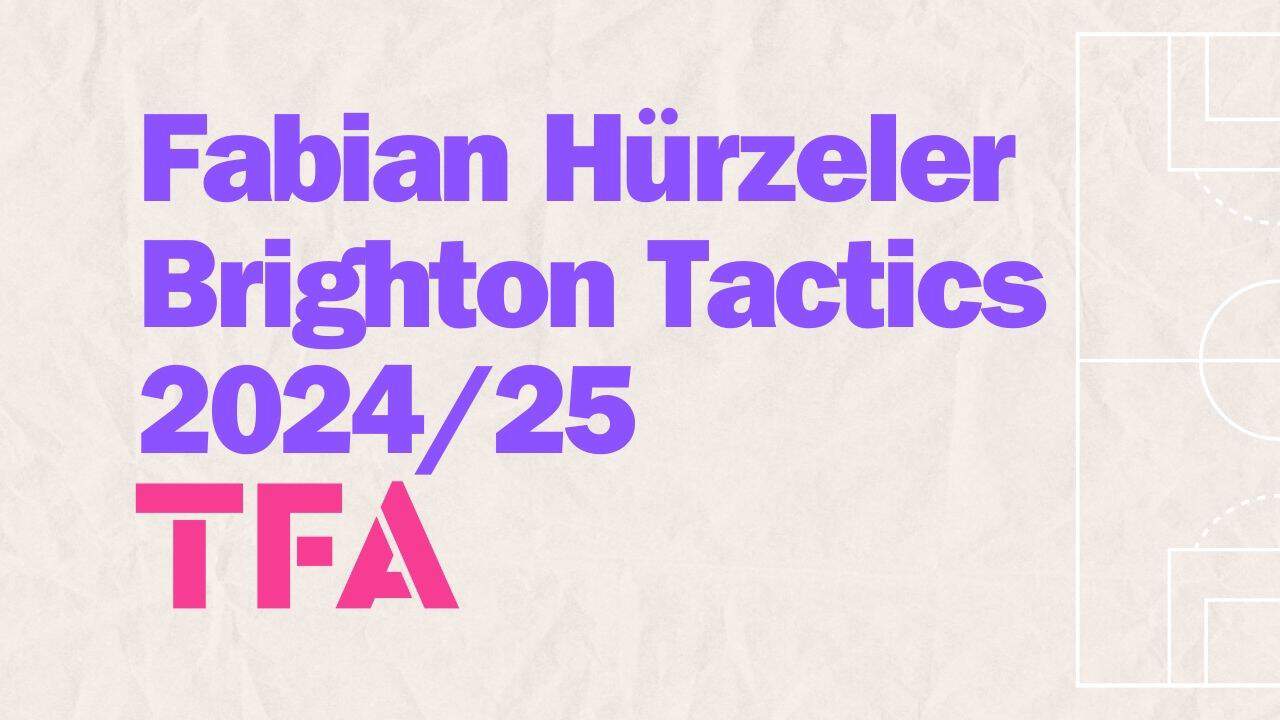



Comments